Related Research Articles
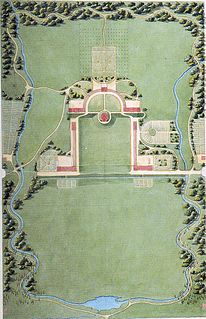
A campus is traditionally the land on which a college or university and related institutional buildings are situated. Usually a college campus includes libraries, lecture halls, residence halls, student centers or dining halls, and park-like settings.

Daniel Chester French was an American sculptor of the late nineteenth and early twentieth centuries, best known for his design of the monumental statue of Abraham Lincoln (1920) in the Lincoln Memorial in Washington, D.C.
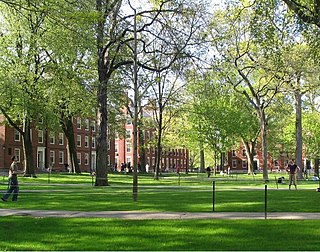
Harvard Yard, in Cambridge, Massachusetts, is the oldest part of the Harvard University campus, its historic center and modern crossroads. It contains most of the freshman dormitories, Harvard's most important libraries, Memorial Church, several classroom and departmental buildings, and the offices of senior University officials including the President of Harvard University.

Henry Hobson Richardson was a prominent North American architect, best known for his work in a style that became known as Richardsonian Romanesque. Along with Louis Sullivan and Frank Lloyd Wright, Richardson is one of "the recognized trinity of American architecture".

Charles Bulfinch was an early American architect, and has been regarded by many as the first native-born American to practice architecture as a profession.

Richard Morris Hunt was an American architect of the nineteenth century and an eminent figure in the history of American architecture. He helped shape New York City with his designs for the 1902 entrance façade and Great Hall of the Metropolitan Museum of Art, the pedestal of the Statue of Liberty, and many Fifth Avenue mansions since destroyed.
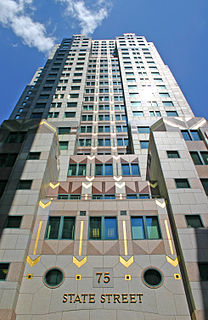
Graham de Conde Gund is an American architect and the president of the Gund Partnership, an American architecture firm based in Cambridge, Massachusetts, and founded by Gund in 1971. An heir to George Gund II, he is also a collector of contemporary art, whose collection has been widely exhibited and published.

The Harvard Graduate School of Design (GSD) is a graduate school of design at Harvard University. Located in Cambridge, Massachusetts, the GSD offers master's and doctoral programs in architecture, landscape architecture, urban planning, urban design, real estate, design engineering, and design studies.
The Porcellian Club is an all-male final club at Harvard University, sometimes called the Porc or the P.C. The year of founding is usually given as 1791, when a group began meeting under the name "the Argonauts", or as 1794, the year of the roast pig dinner at which the club, known first as "the Pig Club" was formally founded. The club's motto, Dum vivimus vivamus is Epicurean. The club emblem is the pig and some members sport golden pigs on watch-chains or neckties bearing pig's-head emblems. The club was originally started by a group of 30 students from Massachusetts who wanted to avoid the dining halls and their food by roasting pigs.
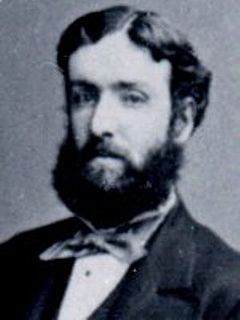
Bruce Price was an American architect and an innovator in the Shingle Style. The stark geometry and compact massing of his cottages in Tuxedo Park, New York, influenced Modernist architects, including Frank Lloyd Wright and Robert Venturi.
Norcross Brothers Contractors and Builders was a prominent nineteenth-century American construction company, especially noted for their work, mostly in stone, for the architectural firms of H.H. Richardson and McKim, Mead & White. The company was founded by James Atkinson and Orlando Whitney, who were contracted for their first project in 1869. In all, the company is credited with completing over 650 building projects.

McKim, Mead & White was an American architectural firm that came to define architectural practice, urbanism, and the ideals of the American Renaissance in fin de siècle New York. The firm's founding partners Charles Follen McKim (1847–1909), William Rutherford Mead (1846–1928) and Stanford White (1853–1906) were giants in the architecture of their time, and remain important as innovators and leaders in the development of modern architecture worldwide. They formed a school of classically trained, technologically skilled designers who practiced well into the mid-twentieth century. According to Robert A. M. Stern, only Frank Lloyd Wright was more important to the identity and character of modern American architecture.

The Johnston Gate is one of the several entrances to Harvard Yard in Cambridge, Massachusetts. Completed in 1889 after a Georgian Revival design by McKim, Mead, and White, it opens onto Peabody Street just north of Harvard Square. Costing some $10,000, it was the gift of Samuel Johnston.

Sever Hall is an academic building at Harvard University designed by the American architect H. H. Richardson and built in the late 1870s. It is located in Harvard Yard in Cambridge, Massachusetts. It was designated a National Historic Landmark in 1970, recognized as one of Richardson's mature masterpieces.
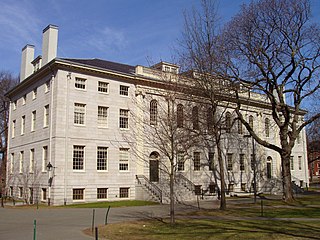
University Hall is a white granite building designed by the great early American architect Charles Bulfinch and built by the noted early engineer Loammi Baldwin, Jr. It is located in Harvard Yard on the campus of Harvard University in Cambridge, Massachusetts. It was designated a National Historic Landmark in 1970 for its architectural significance.

The Harvard Club of New York City, commonly called The Harvard Club, is a private social club located in Midtown Manhattan, New York, USA.
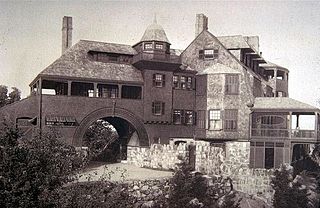
The Shingle style is an American architectural style made popular by the rise of the New England school of architecture, which eschewed the highly ornamented patterns of the Eastlake style in Queen Anne architecture. In the shingle style, English influence was combined with the renewed interest in Colonial American architecture which followed the 1876 celebration of the Centennial. The plain, shingled surfaces of colonial buildings were adopted, and their massing emulated.

William Mitchell Kendall was an American architect who spent his career with the New York firm of McKim, Mead & White, the leading American architectural practice at the turn of the century, renowned for its classical work. Kendall joined the firm in 1882, became a partner in 1906, and remained with the firm until his death in 1941. He was closely associated at the firm with partner Charles Follen McKim until McKim's death in 1909, and added a refined delicacy to McKim’s somewhat severe Roman classicism.
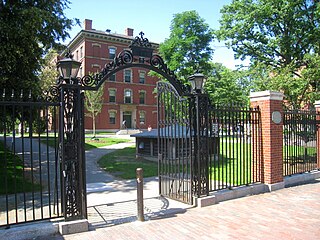
Bradstreet Gate, on the perimeter of Harvard Yard in Cambridge, Massachusetts, is a wrought-iron gate opposite Memorial Hall. In 1997 it was dedicated to Anne Bradstreet on the 25th anniversary of female students living in Harvard's freshman dormitories. A plaque with a quote from one of Bradstreet's poems was added in 2003.
References
- ↑ Topczewska, Ola. Kamin, Blair (ed.). Johnston Gate: Harvard's Oldest and Grandest. Gates of Harvard Yard. Princeton Architectural Press. pp. 18–25. ISBN 9781616894641.
- ↑ Roth, Leland (1983). McKim, Mead & White, Architects . Harper and Row.
- ↑ Shand-Tucci, Douglas (2001). The Campus Guide: Harvard University. Princeton Architectural Press. p. 29–31. ISBN 9781568982809.